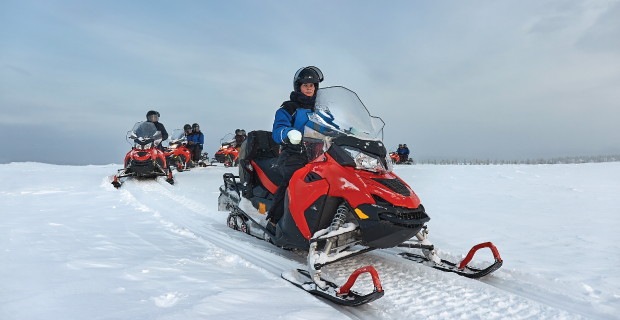Date Published: 2023/12/21
Read Time: mins
Snowmobile safety

Snowmobiling, though enjoyable, still presents certain real dangers. Here are some items to consider before taking off on snowmobile.
Avoid frostbite and other problems
Always dress adequately for the weather. Equip yourself to cope with all conditions, such as temperature changes, journey duration, trail conditions, etc.
Relying exclusively on snowmobile pit stops to warm up is not the best idea. You may arrive at your destination and be faced with a sign that says “closed”.
Avoid dangerous maneuvers
On a snowmobile it is important to always respect the speed limit and keep a safe distance between vehicles.
Keeping to the right at all times when driving is also the best way to avoid getting our skis tangled or have a head-on collision, especially in curves.
Reflexes are not the same from one person to another so why tempt fate unnecessarily?
Avoid solo rides in remote areas
No one can predict a mechanical breakdown, running out of gas or even an accident. It is easy to imagine the mess we would be in if this happened to us on a deserted trail with nobody around to help us.
It is therefore essential to always share your itinerary to a third party; better still, always travel in pairs, especially when traveling on more isolated trails.
Pay attention to big beasts
Those who have already experienced it know how disconcerting it is to see a deer jump in front of their snowmobile, which is why it is important to stay alert and keep your eyes peeled.
Lakes: safe or not?
Never cross an unmarked lake that has not been confirmed as safe by a competent authority. Why? Because there is no certainty that the lake will be safe for your crossing.
Here is some information on how a lake freezes:
- Freezing often starts on the edges, then spreads over the entire lake depending on the currents. For example, the ice is often thicker near the edges or, conversely, the ice may be more fragile if a stream flows nearby. Thus, it is fair to say that it is almost impossible to confirm with certainty that a lake is safe.
- Another point: It is necessary to wait several days of cold for a lake to freeze and the larger and deeper a lake, the longer it will take for the layers of ice to form.
- Also, be aware that the heat of the day can affect the ice. As a result, it may be much more fragile at the end of the day.
- The presence of snow on a lake can also cause warming because snow acts as an insulator. Thus, ice covered with snow is generally thinner and more brittle than bare ice.
IF EVER THE UNTHINKABLE HAPPENS... In the event that the ice begins to break under your snowmobile, do not stop. The vehicle can ride on water for a certain distance if you keep up your speed. This can allow you, for example, to reach the shore or a safer layer of ice.
In closing, if you still want to cross a lake, here is a chart that explains the recommended ice thickness whether on foot, a snowmobile or in a vehicle. But beware, the ice can be very thick in one place and thinner in another.
| Recommended Minimum Ice Thickness for New Clear Hard Ice | |||
|---|---|---|---|
| Single Person | Snowmobile or ATV | Single Vehicle | Pick Up Truck |
| 4 inches (10 cm) | 5 inches (12 cm) | 8-12 inches (20-30 cm) | 12-15 inches (30-38 cm) |